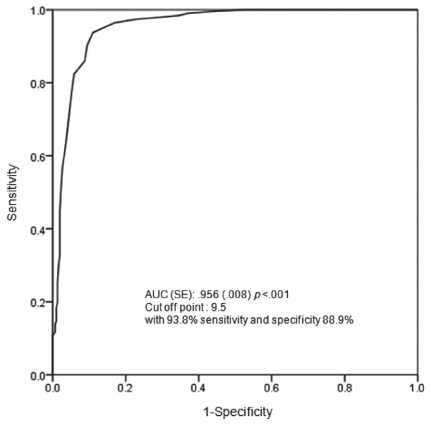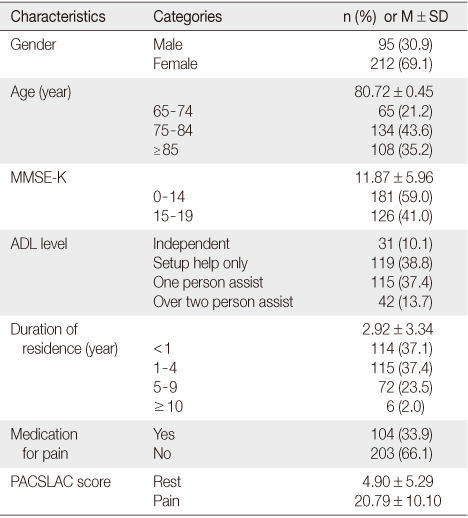Articles
- Page Path
- HOME > J Korean Acad Nurs > Volume 44(4); 2014 > Article
-
Original Article
- Validity and Reliability of the Korean Version of the Pain Assessment Checklist for Seniors with Limited Ability to Communicate
- Eun-Kyung Kim, Se Young Kim, Mi Ran Eom, Hyun Sook Kim, Eunpyo Lee
-
Journal of Korean Academy of Nursing 2014;44(4):398-406.
DOI: https://doi.org/10.4040/jkan.2014.44.4.398
Published online: August 29, 2014
1Department of Nursing, Chungbuk National University, Cheongju, Korea.
2Department of Nursing, Changwon National University, Changwon, Korea.
3Department of Nursing, Mokpo National University, Muan, Korea.
4Department of Nursing, Eulji University, Daejeon, Korea.
5Department of Medicine, Eulji University, Daejeon, Korea.
- Address reprint requests to: Lee, Eunpyo. Department of Medicine, Eulji University, 771-77 Gyeryong-ro, Jung-gu, Daejeon 301-832, Korea. Tel: +82-42-259-1613, Fax: +82-42-259-1539, elee@eulji.ac.kr
© 2014 Korean Society of Nursing Science
This is an Open Access article distributed under the terms of the Creative Commons Attribution NoDerivs License. (http://creativecommons.org/licenses/by-nd/4.0/) If the original work is properly cited and retained without any modification or reproduction, it can be used and re-distributed in any format and medium.
Abstract
-
Purpose
- This study was done to develop and test the validity and reliability of the Korean version of the Pain Assessment Checklist for Seniors with Limited Ability to Communicate (PACSLAC-K) in assessing pain of elders with dementia living in long-term care facilities.
-
Methods
- The PACSLAC-K was developed through forward-backward translation techniques. Survey data were collected from 307 elders with dementia living in 5 long-term care facilities in Korea. Data were analyzed using descriptive statistics, Pearson correlation, Spearman's rho, paired t-test, ROC (receiver operation characteristic) curve with the SPSS/WIN (20.0) program.
-
Results
- The PACSLAC-K showed high internal consistency (.90), inter-rater reliability (.86), intra-rater reliability (.93), and high concurrent validity (.74) in paired t-test with PAINAD. Discriminant validity also showed a significant difference compared with no pain. The PACSLAC-K showed a sensitivity of .93, specificity of .88, and Area Under the Curve of .95 in the ROC curve.
-
Conclusion
- The findings of this study demonstrate that PACSLAC-K is useful in assessing pain for elders with dementia living in long-term care facilities.
- 1. Kaasalainen S. Pain assessment in older adults with dementia: Using behavioral observation methods in clinical practice. J Gerontol Nurs. 2007;33(6):6–10.Article
- 2. Wang JJ, Hsieh PF, Wang CJ. Long-term care nurses' communication difficulties with people living with dementia in Taiwan. Asian Nurs Res. 2013;7(3):99–103. http://dx.doi.org/10.1016/j.anr.2013.06.001Article
- 3. Horgas AL, Nichols AL, Schapson CA, Vietes K. Assessing pain in persons with dementia: Relationships among the non-communicative patient's pain assessment instrument, self-report, and behavioral observations. Pain Manag Nurs. 2007;8(2):77–85. http://dx.doi.org/10.1016/j.pmn.2007.03.003ArticlePubMed
- 4. Zwakhalen SM, Hamers JP, Abu-Saad HH, Berger MP. Pain in elderly people with severe dementia: A systematic review of behavioural pain assessment tools. BMC Geriatr. 2006;6:3. http://dx.doi.org/10.1186/1471-2318-6-3ArticlePubMedPMCPDF
- 5. Cohen-Mansfield J, Creedon M. Nursing staff members' perceptions of pain indicators in persons with severe dementia. Clin J Pain. 2002;18(1):64–73.ArticlePubMed
- 6. AGS Panel on Persistent Pain in Older Persons. The management of persistent pain in older persons. J Am Geriatr Soc. 2002;50:6 Suppl. S205–S224.ArticlePubMed
- 7. Reid MC, Guo Z, Jenq GY, Gill TM. Factors associated with pain-related disability among community-dwelling older persons with chronic pain. J Am Geriatr Soc. 2003;51:Suppl S4. S204.
- 8. Ryoo EN, Park KS. Validity, reliability and efficiency of pain self-report scale in elderly with dementia. Korean J Adult Nurs. 2011;23(2):111–122.
- 9. Pautex S, Herrmann F, Le Lous P, Fabjan M, Michel JP, Gold G. Feasibility and reliability of four pain self-assessment scales and correlation with an observational rating scale in hospitalized elderly demented patients. J Gerontol A Biol Sci Med Sci. 2005;60(4):524–529.ArticlePubMed
- 10. Kim SJ, Ryoo EN, Park KS. A study on pain, physical function, cognitive function, depression and agitation in elderly women with dementia. J Korean Acad Adult Nurs. 2007;19(3):401–412.
- 11. Herr KA, Spratt K, Mobily PR, Richardson G. Pain intensity assessment in older adults: Use of experimental pain to compare psychometric properties and usability of selected pain scales with younger adults. Clin J Pain. 2004;20(4):207–219.PubMed
- 12. Schmader KE, Hanlon JT, Fillenbaum GG, Huber M, Pieper C, Horner R. Medication use patterns among demented, cognitively impaired and cognitively intact community-dwelling elderly people. Age Ageing. 1998;27(4):493–501.ArticlePubMed
- 13. Sloman R, Ahern M, Wright A, Brown L. Nurses' knowledge of pain in the elderly. J Pain Symptom Manage. 2001;21(4):317–322.ArticlePubMed
- 14. Ryoo EN. Verification of self-report scale about pain assessment in elder with dementia [dissertation]. Seoul, Chung-Ang University. 2009.
- 15. Herr K, Bjoro K, Decker S. Tools for assessment of pain in nonverbal older adults with dementia: A state-of-the-science review. J Pain Symptom Manage. 2006;31(2):170–192. http://dx.doi.org/10.1016/j.jpainsymman.2005.07.001ArticlePubMed
- 16. Herr K, Bursch H, Ersek M, Miller LL, Swafford K. Use of pain-behavioral assessment tools in the nursing home: Expert consensus recommendations for practice. J Gerontol Nurs. 2010;36(3):18–29. http://dx.doi.org/10.3928/00989134-20100108-04PMC
- 17. Zwakhalen SM, Hamers JP, Berger MP. The psychometric quality and clinical usefulness of three pain assessment tools for elderly people with dementia. Pain. 2006;126(1-3):210–220. http://dx.doi.org/10.1016/j.pain.2006.06.029ArticlePubMed
- 18. Fuchs-Lacelle S, Hadjistavropoulos T. Development and preliminary validation of the pain assessment checklist for seniors with limited ability to communicate (PACSLAC). Pain Manag Nurs. 2004;5(1):37–49.ArticlePubMed
- 19. Takai Y, Yamamoto-Mitani N, Suzuki M, Furuta Y, Sato A, Fujimaki Y. Developing and validating a Japanese version of the assessment of pain in elderly people with communication impairment. Arch Gerontol Geriatr. 2013;57(3):403–410. http://dx.doi.org/10.1016/j.archger.2013.06.002ArticlePubMed
- 20. Zwakhalen SM, Hamers JP, Berger MP. Improving the clinical usefulness of a behavioural pain scale for older people with dementia. J Adv Nurs. 2007;58(5):493–502. http://dx.doi.org/10.1111/j.1365-2648.2007.04255.xArticlePubMed
- 21. Park JH, Kwon YC. Standardization of Korean version of the minimental state examination (MMSE-K) for use in the elderly. Part diagnostic validity. J Korean Neuropsychiatr Assoc. 1989;28(3):508–513.
- 22. Warden V, Hurley AC, Volicer L. Development and psychometric evaluation of the pain assessment in advanced dementia (PAINAD) scale. J Am Med Dir Assoc. 2003;4(1):9–15. http://dx.doi.org/10.1097/01.jam.0000043422.31640.f7ArticlePubMed
- 23. Chapman DW, Carter JF. Translation procedures for cross-cultural use of measurement instruments. Educ Eval Policy Anal. 1979;1(3):71–76.
- 24. Streiner DL, Norman GR. Health measurement scales: A practical guide to their development and use. 3rd ed. Oxford, UK: Oxford University Press; 2003.
- 25. Zwakhalen SM, Koopmans RT, Geels PJ, Berger MP, Hamers JP. The prevalence of pain in nursing home residents with dementia measured using an observational pain scale. Eur J Pain. 2009;13(1):89–93. http://dx.doi.org/10.1016/j.ejpain.2008.02.009ArticlePubMed
- 26. Kaasalainen S, Akhtar-Danesh N, Hadjistavropoulos T, Zwakhalen S, Verreault R. A comparison between behavioral and verbal report pain assessment tools for use with residents in long term care. Pain Manag Nurs. 2013;14(4):e106–e114. http://dx.doi.org/10.1016/j.pmn.2011.08.006ArticlePubMed
- 27. Sheu E, Versloot J, Nader R, Kerr D, Craig KD. Pain in the elderly: Validity of facial expression components of observational measures. Clin J Pain. 2011;27(7):593–601. http://dx.doi.org/10.1097/AJP.0b013e31820f52e1PubMed
- 28. van Nispen tot Pannerden SC, Candel MJ, Zwakhalen SM, Hamers JP, Curfs LM, Berger MP. An item response theory-based assessment of the pain assessment checklist for seniors with limited ability to communicate (PACSLAC). J Pain. 2009;10(8):844–853. http://dx.doi.org/10.1016/j.jpain.2009.02.007ArticlePubMed
- 29. Fuchs-Lacelle S, Hadjistavropoulos T, Lix L. Pain assessment as intervention: A study of older adults with severe dementia. Clin J Pain. 2008;24(8):697–707. http://dx.doi.org/10.1097/AJP.0b013e318172625aPubMed
REFERENCES

Figure & Data
REFERENCES
Citations

- Quality of Assessment Tools for Aphasia: A Systematic Review
Francescaroberta Panuccio, Giulia Rossi, Anita Di Nuzzo, Ilaria Ruotolo, Giada Cianfriglia, Rachele Simeon, Giovanni Sellitto, Anna Berardi, Giovanni Galeoto
Brain Sciences.2025; 15(3): 271. CrossRef - Feasibility of Using the EuroQol-5 Dimensions to Identify Masticatory Discomfort in Community-Dwelling Older Adults
Han-Nah Kim, Nam-Hee Kim
Journal of Dental Hygiene Science.2025; 25(3): 237. CrossRef - Implementation and evaluation of a pain assessment app and novel community platform for long-term care health professionals
Vivian Tran, Emily Winters, Eleni Stroulia, Thomas Hadjistavropoulos
Aging & Mental Health.2024; 28(4): 611. CrossRef - Measuring Pain in Aphasia: Validity and Reliability of the PACSLAC-D
Neeltje J. de Vries, Jenny T. van der Steen, Wilco P. Achterberg, Hanneke J.A. Smaling
Pain Management Nursing.2023; 24(4): e68. CrossRef - Development of the Korean Version of the Pain Assessment Tool in Impaired Cognition (KPAIC-15) for Patients with Dementia: A Scale Development
Sun Young Lim, Su Jung Lee, Sung Ok Chang
Journal of Korean Gerontological Nursing.2022; 24(2): 218. CrossRef - Reliability and Feasibility of the Pain Assessment in Advanced Dementia Scale–Korean Version (PAINAD-K)
So-Hi Kwon, Yeon-Su Cho, Hyunsim Kim
Pain Management Nursing.2021; 22(5): 660. CrossRef - Validation of Pain Assessment Checklist for Seniors with Limited Ability to Communicate‐II (PACSLAC‐II) in Iranian older adults with dementia living in nursing homes
Marjan Haghi, Reza Fadayevatan, Mahtab Alizadeh‐khoei, Bijan Kaboudi, Mahshid Foroughan, Behrouz Mahdavi
Psychogeriatrics.2020; 20(3): 278. CrossRef - Development and Effect of Evidence-based Nursing Practice Guidelines for Pain Management in Patients with Dementia
Young Seun Ryu, Jeong Sook Park
Korean Journal of Adult Nursing.2019; 31(2): 176. CrossRef - Protocolos de gestión del dolor en demencia avanzada
Mercedes Montoro-Lorite, Montserrat Canalias-Reverter
Enfermería Clínica.2018; 28(3): 194. CrossRef - Advanced dementia pain management protocols
Mercedes Montoro-Lorite, Montserrat Canalias-Reverter
Enfermería Clínica (English Edition).2018; 28(3): 194. CrossRef - Pain assessment in elderly with dementia: Brazilian validation of the PACSLAC scale
Karol Bezerra Thé, Fernanda Martins Gazoni, Guilherme Liausu Cherpak, Isabel Clasen Lorenzet, Luciana Alves dos Santos, Edlene Maria Nardes, Fânia Cristina dos Santos
Einstein (São Paulo).2016; 14(2): 152. CrossRef - Nonverbal Pain Measurement for Elders: A Literature Review
Kyung Mi Lee, Jun-Ah Song
Journal of Korean Gerontological Nursing.2016; 18(3): 147. CrossRef - Factors affecting nurse's pain management for patients with dementia
Young-Seun Ryu, Jeong-Sook Park
Journal of the Korea Academia-Industrial cooperation Society.2016; 17(9): 253. CrossRef
- Figure
- We recommend
- Related articles
-
- Reliability and validity of the Korean version of the Nurses Professional Values Scale-3 for nursing students: a methodological study
- Validity and Reliability of the Korean Version of the Occupational Coping Self-Efficacy Scale for Nurses
- The Reliability and Validity of the Korean Version of the 5C Psychological Antecedents of Vaccination Scale

Figure 1
General and Pain-related Characteristics of Participants (N=307)
MMSE-K=Mini-Mental State Examination Korean version; ADL=Activities of Daily Living; PACSLAC=Pain Assessment Checklist for Seniors with Limited Ability to Communicate.
Inter-rater Reliability and Test-retest Reliability of PACSLAC (N=30)
PACSLAC=Pain Assessment Checklist for Seniors with Limited Ability to Communicate.
Concurrent Validity of PACSLAC Tool for Pain (N=307)
PACSLAC=Pain Assessment Checklist for Seniors with Limited Ability to Communicate; PAINAD=Pain Assessment in Advanced Dementia Scale.
Discriminant Validity: Comparison of PACSLAC Scores Measured at Rest and in Pain (N=307)
PACSLAC=Pain Assessment Checklist for Seniors with Limited Ability to Communicate.
MMSE-K=Mini-Mental State Examination Korean version; ADL=Activities of Daily Living; PACSLAC=Pain Assessment Checklist for Seniors with Limited Ability to Communicate.
PACSLAC=Pain Assessment Checklist for Seniors with Limited Ability to Communicate.
PACSLAC=Pain Assessment Checklist for Seniors with Limited Ability to Communicate; PAINAD=Pain Assessment in Advanced Dementia Scale.
PACSLAC=Pain Assessment Checklist for Seniors with Limited Ability to Communicate.
 KSNS
KSNS
 E-SUBMISSION
E-SUBMISSION




 Cite
Cite

